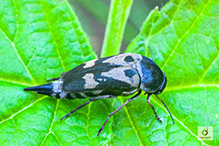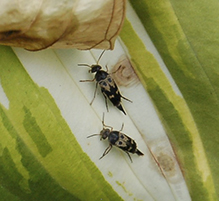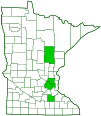eye-spotted tumbling flower beetle
(Glipa oculata)
Conservation • Description • Habitat • Ecology • Distribution • Taxonomy
|
|
||||||||||||||
Description |
Eye-spotted tumbling flower beetle is a small beetle but a relatively large tumbling flower beetle. It occurs in the United States and southern Canada east of the Great Plains. It is uncommon throughout its range. Adults are found from May to October. They feed on the pollen and nectar of giant ragweed and possibly other flowers in the Aster (Asteraceae) family. Adults are wedge-shaped and ¼″ to 5⁄16″ (7 to 8.5 mm) in length. They are more or less arched and appear humpbacked when viewed from the side. They are mostly black above with sharply defined areas covered with ash gray, yellowish, or golden yellow (pale) hairs. The head is large, short, bent downward, black, and covered with pale hairs. It is attached toward the bottom to the body. There are two large compound eyes and no simple eyes (ocelli). The eyes are not hairy, and they do not reach the back of the head (occiput). The antennae are short, reaching just to the middle of the thorax. They have 11 segments. Segments 1 through 4 are dull brick red. Segments 5 through 11 are saw-toothed (serrate) and black. The mouthparts are directed downward. The finger-like sensory mouthparts (palps) are pale. The last segment (palpomere) is triangular on both sexes. The plate on the upper side of the thorax (pronotum) is black, small, slightly wider than long, and evenly rounded in front. The base is broader than the wing covers (elytra), and it has a broad rounded lobe in the middle. There is a band of pale hairs at the base and on the margins of the pronotum. The plate between the wing bases (scutellum) is triangular, rounded at the tip, and covered with pale hairs, at least on the margins. The abdomen is narrow and pointed, and it extends well beyond the end of the elytra. The length of the body to the end of the elytra is 3⁄16″ to ¼″ (5 to 6 mm). At the tip of the abdomen there is a long, pointed extension (anal style). The anal style is black and is covered with pale hairs at the base. The underside of the abdomen is striped black and ash gray. The elytra are usually black, sometimes dark reddish-brown. At the base of each elytron there is a broad, rounded, pale band. The band extends to a point in the rear nearly to the middle of the elytron. Near the middle of the band there is a large, round, black spot. The pair of eye-like spots is the source of the common name and probably also the species epithet of this beetle. Behind the middle of each elytron there is an angulated pale band that on most individuals does not reach the middle margin (suture) or the side margin. The leg color is variable, mostly reddish-brown or pale yellowish-brown with black areas. |
Size |
Length to end of elytra: 3⁄16″ to ¼″ (5 to 6 mm) Total length: ¼″ to 5⁄16″ (7 to 8.5 mm) |
Similar Species |
Habitat |
|
Ecology |
Season |
May to October |
Behavior |
When threatened, the beetle may rapidly take flight, or it may kick its legs back and forth, causing it to tumble unpredictably. This is the feature that gives the family Mordellidae the common name tumbling flower beetles. |
Life Cycle |
|
Larva Food |
Larvae feed within the stems of plants that may be different species than the plants that the adults feed on. |
Adult Food |
Pollen and nectar of giant ragweed and possibly other Aster (Asteraceae) plants. |
Distribution |
||
|
Sources
* "Mordella octomaculata" |
|
| 7/7/2025 | ||
Occurrence |
||
|
||
Taxonomy |
|
Order |
Coleoptera (Beetles) |
Suborder |
Polyphaga (Water, Rove, Scarab, Long-horned, Leaf, and Snout Beetles) |
Infraorder |
Cucujiformia |
Superfamily |
Tenebrionoidea (darkling beetles and allies) |
Family |
Mordellidae (tumbling flower beetles) |
Subfamily |
Mordellinae |
Tribe |
Mordellini |
Genus |
Glipa |
This species was originally described as Mordella oculata in 1835. In 1945 it was moved to the genus Glipa. As Glipa is currently defined, this species should not be included. It has been suggested that it be moved back to Mordella or to the newer genus Hoshihananomia. Moving it would require a redescription of the species to be published. To date, that has not happened. |
|
Subordinate Taxa |
|
|
|
Synonyms |
|
Mordella jovialis Mordella octomaculata ? |
|
Common Names |
|
eye-spotted tumbling flower beetle |
|
Glossary
Elytra
The hardened or leathery forewings of beetles used to protect the fragile hindwings, which are used for flying. Singular: elytron.
Occiput
The back of the head. In Odonata, Megaloptera, and Neuroptera, the upper part of the head behind the eyes.
Ocellus
Simple eye; an eye with a single lens. Plural: ocelli.
Palp
Short for pedipalp. A segmented, finger-like process of an arthropod; one is attached to each maxilla and two are attached to the labium. They function as sense organs in spiders and insects, and as weapons in scorpions. Plural: palpi or palps.
Pronotum
The exoskeletal plate on the upper side of the first segment of the thorax of an insect.
Scutellum
The exoskeletal plate covering the rearward (posterior) part of the middle segment of the thorax in some insects. In Coleoptera, Hemiptera, and Homoptera, the dorsal, often triangular plate behind the pronotum and between the bases of the front wings. In Diptera, the exoskeletal plate between the abdomen and the thorax.
Visitor Photos |
||
Share your photo of this insect. |
||
This button not working for you? |
||
Mike Poeppe |
 |
Bob Payton |
 |
MinnesotaSeasons.com Photos |
||
|
||
|
||

Slideshows |
|

Visitor Videos |
||
Share your video of this insect. |
||
This button not working for you? |
||
|
Other Videos |
||
|

Visitor Sightings |
||
Report a sighting of this insect. |
||
This button not working for you? |
||
Mike Poeppe |
Location: near Houston, MN |
 |
| Bob Payton 7/3/2022 |
Location: South Minneapolis, Howe neighborhood |
 |
MinnesotaSeasons.com Sightings |
||
|

Created: 12/21/2022 Last Updated: © MinnesotaSeasons.com. All rights reserved. |
